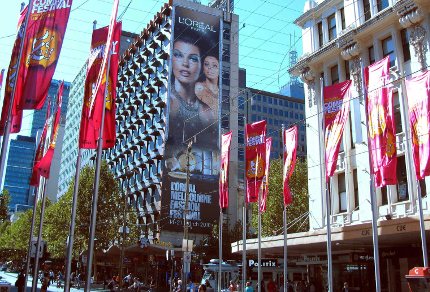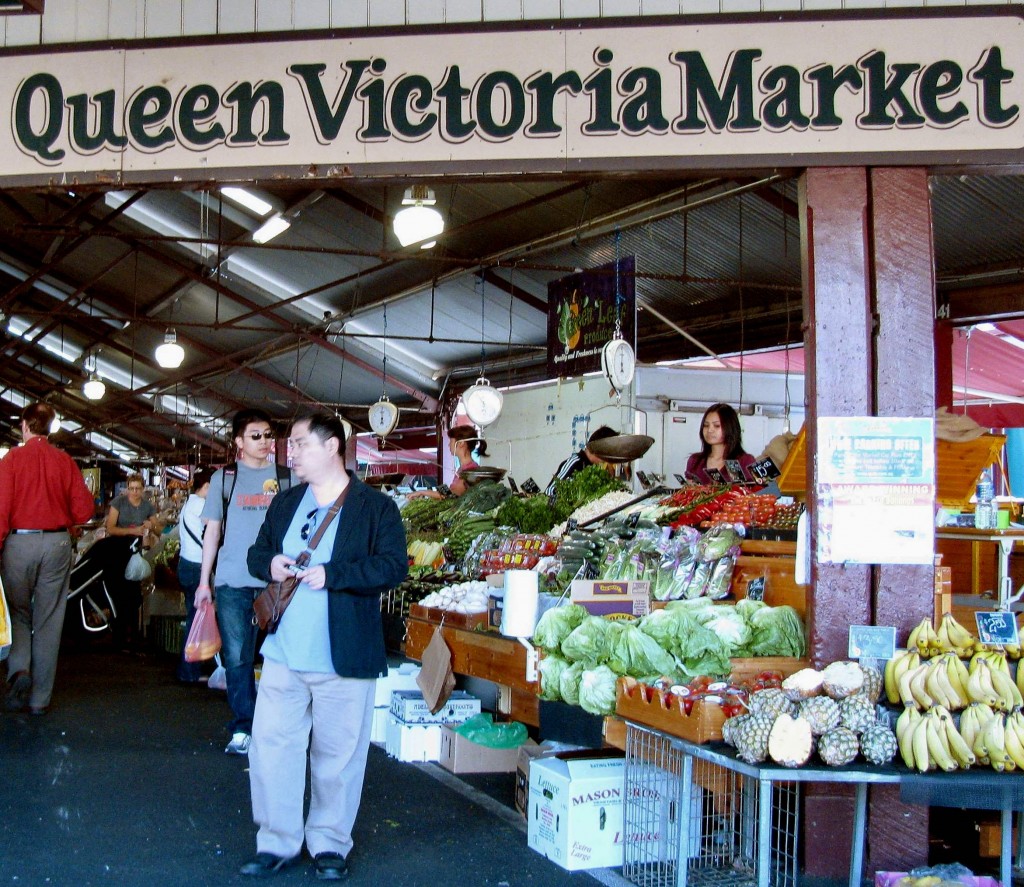
Produce Vendors in Queen Victoria Market, Melbourne (© Magi Nams)
Melbourne’s Chinatown was quiet when I walked through it early this morning. I saw only delivery trucks as I headed for Elizabeth Street, which I followed northwest to Queen Victoria Market. As I strode along Elizabeth, I heard a startling but delightful sound and turned to see a toddler in a stroller singing sweetly alongside street traffic and the rattle of streetcars.
When I reached the market, which was established in 18781 and now covers about two city blocks at the northwestern edge of Melbourne’s city core, I entered a permanent display building redolent with the fragrance of fresh fish and seafood. Within it, refrigerated display case after display case was filled with flounder, salmon, bonito, whiting, barramundi, crabs, crayfish, prawns, and mussels, or with meats arranged like artworks – lamb chops in neat, pale-edged circles on trays, ground beef in machine-swirled molds, porterhouse steaks an inch and a half thick stacked in overlapping stairs edged with parsley. Men and women shouted out their business’s specialties, attempting to attract customers away from competing vendors across from them or just down the aisle.

Smoked Meat and Cheese Vendor in Queen Victoria Market (© Magi Nams)
Farther into the market, bakeries stocked with loaves, buns, and sweets shared aisles with cheese stores, delicatessans, and business selling smoked meats, pastas, wines, nuts, and candies. I enjoyed the astonishing variety and sheer number of displays so much, I walked through the building twice before stepping out into open markets beneath huge, warehouse-sized roofs. There, fruits and vegetables, cartons of eggs and containers of honey were piled on tables. Buckets of fresh flowers added splashes of brilliant colour to an already colourful scenario of customers perusing the offerings and vendors hawking their products.
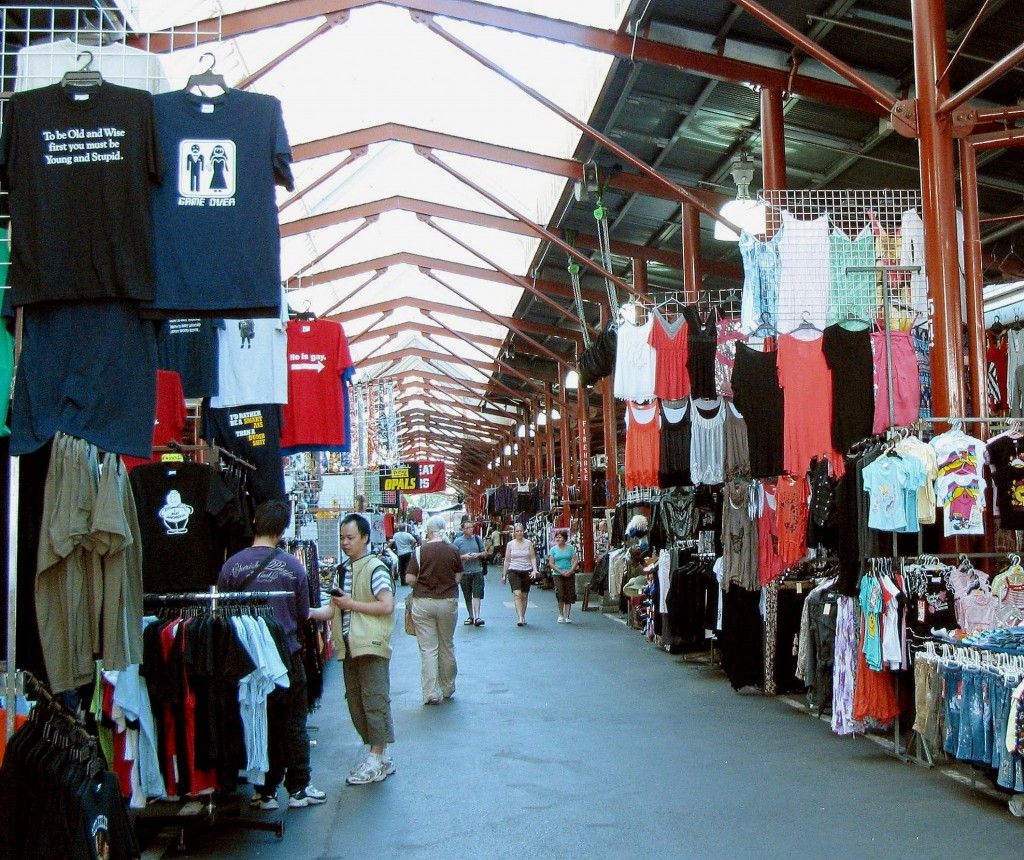
Clothing Vendors at Queen Victoria Market (© Magi Nams)
Crossing a street, I left the world of fresh edibles for that of the department store. Open warehouses were cluttered with vendors selling clothes, shoes, jewellery, luggage, sheep and kangaroo skins, souvenirs, and in a surprising display, original Aboriginal art. As the temperature of the morning soared, so did the number of customers and the noise level in the market.
With lunchtime approaching, I purchased a piece of Aboriginal art before taking a circuitous route back to the Rydges. After heading down Queen Street, I followed A’Beckett Street to Flagstaff Gardens, a disappointingly open green space with beds of wilting shrubs and flowers and avenues edged with thin-canopied shade elms showing evidence of extensive leaf chewing by some pest. Within the gardens, school children on an outing sported pale blue polo shirts and burgundy shorts, or black and white checked dresses with white collars and cuffs. Their excited voices splashed life into the tired-looking gardens.

Bourke Street, Melbourne (© Magi Nams)
Leaving the gardens, I followed Latrobe Street back to Elizabeth, and then took Bourke Street, which I quickly realized was shopping central in Melbourne, with Calvin Klein, Lululemon, and numerous other clothing and fashion stores bordering the big rectangular stone pavers that formed wide walkways on both sides of the street. A huge banner on a building advertised the L’Oreal Melbourne Fashion Festival, which began on Sunday, and pink banners atop poles announced the upcoming Melbourne International Comedy Festival, starting March 24.
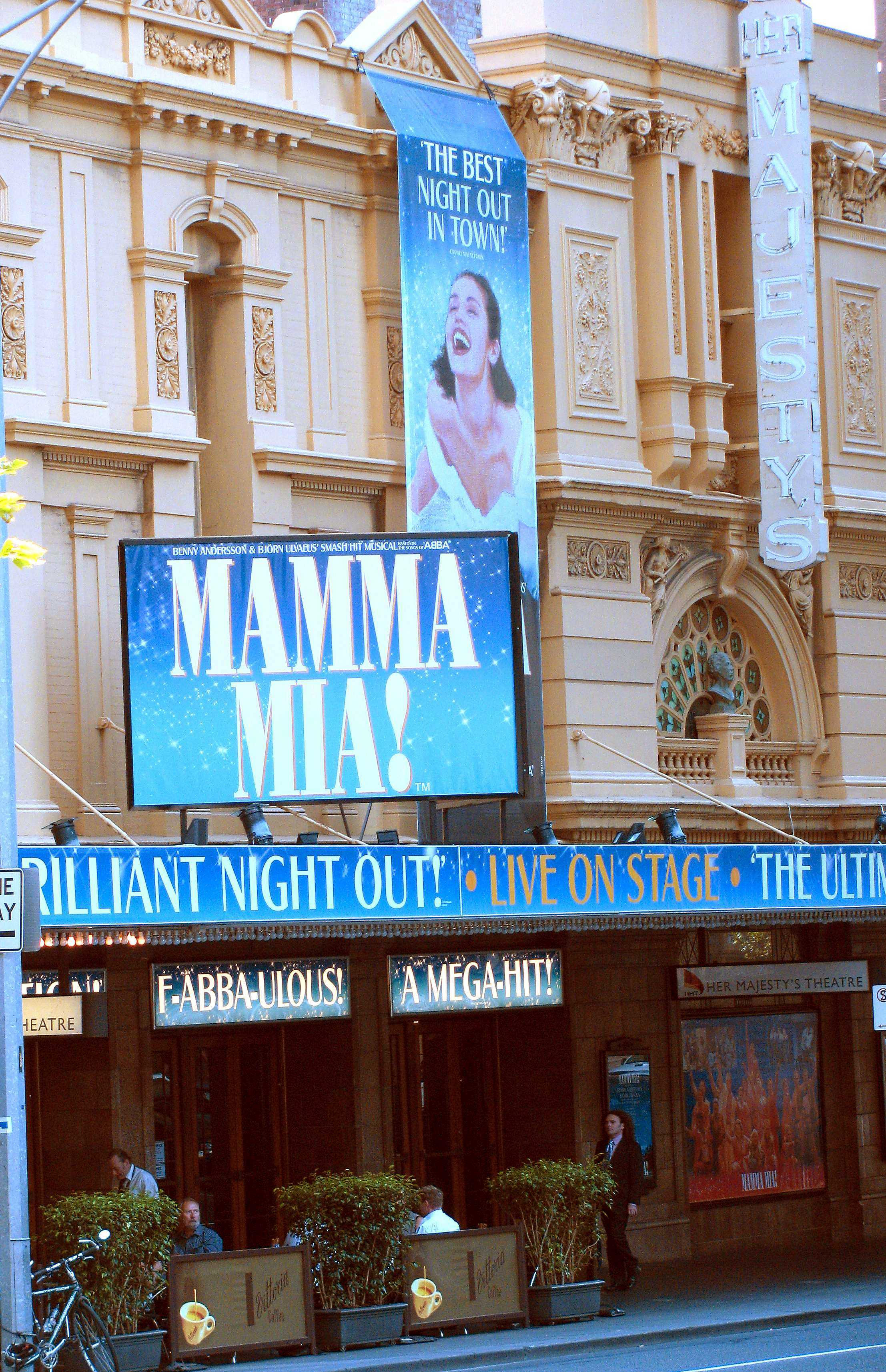
Her Majesty’s Theatre in Melbourne (© Magi Nams)
The city certainly appeared to be living up to its title of ‘Cultural Capital of Australia,’2 this description supported by the number of downtown theatres I’d passed during my explorations yesterday and today, including Her Majesty’s Theatre with its production of Mama Mia! just down the street from the Rydges. Melbourne, which is also the political capital of the state of Victoria2 and hosted the national parliament for 27 years while national government buildings were being constructed in Canberra2, is credited with giving birth to Australian film, television, impressionistic art, and a couple of dances, as well as Australian Rules Football.2 It’s seen as a hotbed of both contemporary and traditional Australian music, and occupies a spot in the top ranks of the world’s most livable cities.2 In short, it’s one of Australia’s cultural gems.
Back at the hotel, I shared lunch with Vilis, who told me the animal movement conference was both stimulating and instructive, giving him ideas for future research. Then I put my sneakers on again and walked to the Melbourne Museum as quickly as possible in the afternoon heat.
Within the museum – its interior seemed all glass and metal angles – I explored the Science and Life Gallery thoroughly and wandered past the forest gallery and through the Bunjilaka Aboriginal Cultual Centre and Mind and Body Gallery. I learned that the exhibit of the pygmy blue whale skeleton in the museum hall required 8 years of preparation from the time the dead whale washed ashore in 1992 and was subsequently loaded onto an extended flatbed truck by cranes, until it was mounted on glass and metal in the museum.

Pygmy Blue Whale Skeleton in Melbourne Museum (© Magi Nams)
I saw the cast of a skeleton of the gigantic extinct monitor lizard Megalania, which inhabited Australia and was the largest land-dwelling lizard ever to live on earth. I wasn’t surprised that the biggest lizard ever came from Oz, but it was rather terrifyingly large. I wouldn’t have wanted to stumble over that one in the desert.
Staring at two stuffed reticulated pythons (thankfully not from Australia) that were 6 ½ metres long and had midsections thicker than my thighs, I could almost feel the air escaping from my lungs never to return. The insect exhibits were particularly good and a lot less threatening, with glorious collections of butterflies that flashed blue and green in the light. I learned that the museum houses Australia’s largest live bug collection, which included ants, cockroaches, katydids, and spiders that did their thing for all to see. I also learned that Austalia is home to almost 400 species of cockroaches (not just the ones that inhabit our house), which vary from big, powerful burrowers that feed on dry eucalypt leaves, to brightly-coloured nectar-feeding species that love to soak up the sun. In a bit of fascinating biological math displayed on a museum wall, I read that, if all the world’s plant and animal species were lined up end to end, two thirds of them would be insects, a third would be beetles, and a seventh would be weevils.
In addition to being highly informative, at least one of the bug displays was downright funny. It related how scientists in Western Australia noticed that (and I’ll quote this, since it tells the story so well) “population numbers of Blakewell’s Jewel Beetle were plummeting. They found that the male beetles had discovered beer! Beer ‘stubbies’ discarded on roadsides, were covered in male beetles. These bottles were orange and dimpled – just like female jewel beetles, only much, much bigger. While the males tried desperately to mate with the biggest females they had ever seen, the real female beetles were completely ignored. The problem ‘stubby’ has been redesigned to make it less attractive. Female beetles are now receiving the attention they deserve and populations are recovering.”
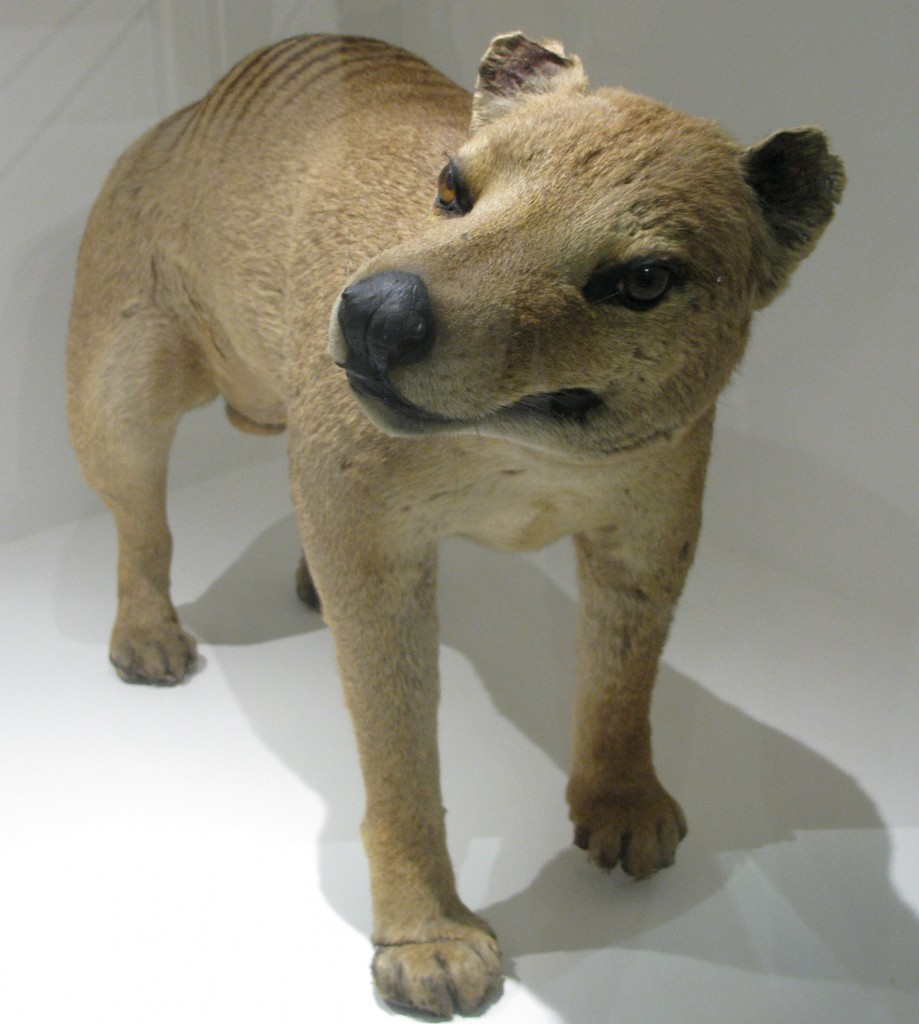
Thylacine (© Magi Nams)
Two displays filled me with sorrow. The first was a stuffed thylacine, a Tasmanian tiger. The taxidermist had positioned the marsupial carnviore (presumed extinct) in such a way that its blocky head was slightly tilted, as if in inquiry. Its glass eyeballs stared brightly but unseeingly, its ears were frayed at the tips, and its tawny body sloped back to hips and tail, with brown stripes spearing down over its hindquarters. It was displayed in a pristine white, glass-fronted case off to one side, and to me seemed to be inquiring why the people of this country had destroyed its existence.
The second intensely disturbing display was one in the Aboriginal Cultural Centre that documented horrific acts of violence against Aboriginal people in the 19th century. I was unable to watch a video, but heard its reference to a sawyer bashing out children’s brains. Quotes reproduced on the display walls stated “…men, women and children are shot wherever they can be met with…” (Henry Meyrick 1846). “…the best way [to procure a run] is to go outside and take up a new run, provided the conscience of the party is sufficiently seared to enable him without remorse to slaughter natives…” (Niel Black 1839). “…this would not be allowed in civilized society.” G.A. Robinson, the Chief Protector of Aborigines.
My interest killed by these displays, I headed back to the Rydges and met Vilis for supper. Tonight, we walked the restaurant gauntlet on Lygon Street, which appeared to be Little Italy with a few Indian and Turkish restaurants thrown in. The aggressive and sometimes smarmy comments made by hawking restaurant owners and employees made us so uncomfortable that we ordered Indian take-out – vegetable samosas, marinated tandoori chicken, seekh kebab of minced lamb and herbs – and ate it in blessed peace on a park bench in Argyle Square.
References:
1. Queen Victoria Market since 1878. Accessed 10-Jun-2010. http://www.qvm.com.au/
2. Wikipedia. Melbourne. Updated 9-Jun-2010. Accessed 10-Jun-2010. http://en.wikipedia.org/wiki/Melbourne

